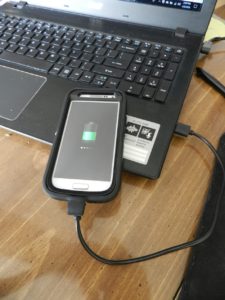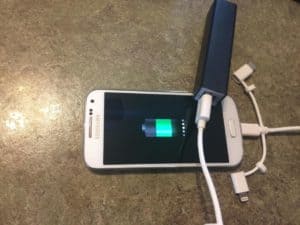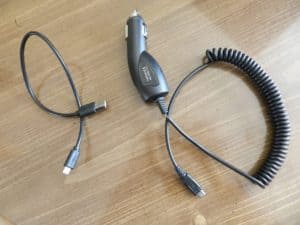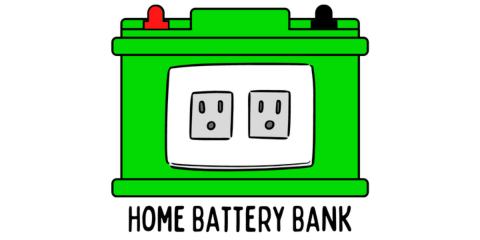This scenario usually hits us in one of two ways: 1.) Either we are at home and the power fails during our favorite sitcom, or, 2.) we are traveling and don’t have access to regular wall outlets.
Either way, it’s an inconvenience not having reliable AC power running through the outlets. If you value your phone anything like I do, that inconvenience is multiplied by a factor of 10!
How can we charge our cell phones or our portable battery packs without standard forms of electricity?
The easiest way to charge a cell phone in the home without conventional electricity is to disconnect and bring your car’s battery inside (kept away from children and pets). Next, connect a DC to AC power inverter to the correct battery terminals. Finally, run an extension cord from the inverter to your phone charger.
That is the short and concise answer for the most long-term solution without having a generator and stored gasoline on hand. Without running your car to recharge it, you could likely get 4-4.5 hours of charge out of a typical 45AH car battery before it wouldn’t be capable of starting your car anymore. Run the car for 30 minutes here and there to top it off and you’ll be good for a long time!
Still, we’ll cover a few other means to scavenge a full or partial charge in case things get bad.
Harvesting from sources nearby that you might already have at hand
Laptop Computer

The trusty laptop likely sits there on your desk or table at home and doesn’t draw a lot of attention. During a short-term power outage though, that unassuming laptop has some charging potential for your phone.
All you’ll need for this is a USB cord that plugs into the USB ports of the laptop and your phone. Pretty simple, right?
Just make sure you save and backup anything that you might need on the computer now that the power has failed. In between charges, place your laptop in hibernation/sleep mode to conserve the power in the laptop.
Sleep mode will be best if you’re just stepping away for a short time, but you can put it in hibernation mode if it’s going to be a few hours or more.
When using the laptop, be sure to reduce the brightness of the screen to its lowest setting to conserve battery power.
Certain phones may respond better to a charge than others. When I plugged in a Samsung phone and an iPhone, the Samsung charged at a faster rate (though still slow by normal standards).
More than anything, the computer will be a very slow charge and may not be as much as you would expect. I find that the computer serves its purpose best if you hook the phone up to it to maintain the current charge of the phone and not expect to build your charge by very much.
At 2.8AH, the computer battery would only give me 30 minutes of charge anyway until the battery is spent if it were programmed to allocate all of that power to my phone.
Portable Power Bank
So many of us have one these days, and they are great in a pinch — like a power outage or out hiking in the woods.
You simply power up the power bank and keep it topped off before the storm hits, and many offer 2 or more full charges that you can harvest before the unit needs to be recharged again.

When times are good, get familiar with yours and know what it can do. The next time you need it you’ll have a great idea of how to ration out your power until power is restored or you make it back to civilization after your trail hike.
If you can find a trusty one that is solar powered as well, you’re in an even better situation! Sometimes the designs and builds can be quite fickle (for solar or regular pocket chargers), so I recommend researching and reading all of the reviews on Amazon to make sure your purchase is going to be a good one.
Your Car
It’s not a glamorous solution but it is probably one option that most of us have and it is very trusty, though it can be a little inconvenient.
If you’re at home and the power goes out, the inconvenience will be having to go out and physically be in the car when it is charging if your ports only work when the key is turned in the ignition.
Some cars will have cigarette lighter ports and USB ports. My vehicle will not power through the USB port if the car is off, but both cigarette lighter ports are always live.
If you can get a phone charger that plugs into the DC (cigarette lighter) port, DO IT! The charge that comes from that port is way faster than the charge you’ll get by having your device plugged into the USB port.

Also, keep in mind that you are draining the battery if your car is not running and you are doing a lot of charging. You’ll need to start your car every once in a while and let it run for a little while to let the alternator recharge the battery. The last thing you’ll want is to charge all of your devices over the course of days and not be able to get the car to start up when you need it to!
The anxiety that comes with knowing that I am damaging my car battery by not having the car running while I’m using it, and not knowing if I’ll be able to start my car in the morning is enough that it made me buy a deep cycle battery setup for that reason alone.
Portable Jump Starter Packs
These little devices for jump-starting your car’s battery are getting smaller in size every year it seems. I have one that is dead and is from 15 years ago and the thing is the size of a car battery itself. Now, they are looking like the size of a novel or smaller!
The cool thing about them evolving over time (besides them getting smaller) is that they now almost always have USB and other ports built into them. If you decide you’d like to pick one up, make one of your considerations the types of ports that they have built into them.
Just like your portable pocket chargers, you’ll need to have this device charged up and ready before the event happens. It will do you know good if you let it die a few months ago and forgot to plug it in.
My lesson learned from 10-15 years ago is that leaving a battery fully discharged over a long period of time will kill the battery permanently. This is what happened with my portable jump starter pack. I had used the built-in light for something and neglected it for a year or more after that. It never held a charge after that. Costly mistake and well before the days before I was concerned with being ready for a power outage.
Inverters are the most versatile item to add to your blackout kit!
Hands down, the best thing you can add to your home or apartment is a DC to AC Power Inverter! This little device (about the size of a large novel like War and Peace) will take energy from your car battery (which is direct current) and invert it so that it comes out like the power from your household outlets (alternating current). Not only will you be able to power your phones, laptops, and cell phone charging devices, you’ll be able to get some basic lighting in your house as well!
The size of the inverter is subjective, but I recommend at least purchasing a 400-watt inverter if you’re just getting your feet wet. Having both a 400 and an 800/1,000 watt inverter is even better in case one fails or you need to power something a little larger.

For a beginner’s guide to buying an inverter, feel free to check out my article here.
Smaller inverters like the 400-watt usually come with two sets of cords.
The first will attach directly to your inverter and the other end will have alligator clips which will clip on to your car battery terminals. This is great to power anything that is requiring a total draw of over 150 watts.
The second set will attach to the inverter and the other end will have a DC plug which will fit right into your cigarette lighter in your car. This is a great option if you don’t have a cigarette lighter phone charger and want to charge your phone fast.
Just plug it into the cigarette lighter port and then plug your normal wall charger into the inverter! My wife and I do this all the time if we want to charge our phones quickly during the road trips that we take to visit her parents.
The versatility of an inverter comes into play in several ways:
- Car running, inverter hooked directly to battery, extension cord running into the house, appliances/phones/lights being powered (total wattage not exceeding the inverter wattage rating)
- Car not running, inverter hooked directly to the battery, the extension cord running into the house, one or two small units drawing power from the battery (a phone or two and a couple LED lights. The car must be restarted periodically to let the alternator recharge the battery.
- Battery removed from the car and brought into house or apartment, inverter hooked directly to the battery, only a few small items hooked up (a couple LED lights and a phone or two). Again, the battery will have to be taken out and hooked up every now and then to recharge the battery. Click here to read my article that will break down how long a car battery can power a TV to get a better understanding of its capacity.
- The inverter can be plugged into the DC port (cigarette lighter) and used when in the vehicle to power anything requiring 150 watts or less.
Finally, you could buy an inverter and a deep cycle battery which is designed for running low-draw devices over a long period of time. For a couple hundred dollars, you could put together a deep cycle marine battery, a charger for it, and an inverter and your household would be set with a basic power setup for years to come as long as you maintained the battery.
Conclusion
When it comes to powering my phone or devices during a power outage, I truly believe that having at least a power inverter for your car battery is the first step that should be taken. It will allow you to power your phone and other low-draw devices and lighting.
I personally made a DIY, dedicated deep-cycle battery backup system to take care of this particular situation and the car battery is not needed.
Car batteries are not meant or designed to supply power to low draw items for extended periods of time while not being charged simultaneously. Every time you choose to run items for an extended period from your car without the car running, you are damaging the battery.
If you’re going to use the car, keep it running if possible or run it frequently. Feel free to check out my article here on how to run appliances and lights from a car. Know that it’s certainly possible, but not the healthiest thing to do to your car battery over the long term. You’d be much better served with at least a deep cycle marine battery.
If you do decide to only use a car battery and inverter, it would be wise to buy a digital voltmeter or purchase an inverter with an LED display that will tell you the voltage of your battery. When it gets to 12.2 volts I recommend disconnecting your devices, putting the battery back in the car, and running it for an hour at idle (or drive it around for a half hour) to recharge it.
Anything below 12.2 volts and its starting to look like a coin toss on whether or not it will start your car!
Either way, I wish you the best of luck getting your phone charged up during the next time where you can’t get power out of a household outlet!
